Back
Cereal is a go-to breakfast for many. This is partly due to the convenience, but mostly due to the association we’ve developed from years of marketing campaigns telling us that cereal is a nutritious breakfast option. This blog post is going to dive into the harsh reality of breakfast cereals, while spotlighting the alternatives that meet our real food philosophy and support our health goals.
What makes it difficult to find a healthy cereal in the supermarket?
With a whole isle dedicated to it in the supermarket, you’d think it would be easy to find a healthy breakfast cereal. The sad reality is that it’s not the case. Most cereals are highly processed and full of sugar, even the ones that are marketed as healthy. For this reason, it’s almost impossible to find a healthy cereal in the supermarket. This is because the big food brands have focused on creating cereals that taste great and are cheap for them to manufacture. This has resulted in high sugar options, which taste delicious and have us going back for more, but are not good for our blood sugar levels or general health. Alongside sugar, cereals tend to be made of highly processed and nutritionally void ingredients that are not setting us up with the nutrients that we need to start our day.
Qualities of a healthy cereal
A healthy cereal, is a muesli or granola that’s made of real food ingredients like whole grains, nuts and seeds. Ideally it has a good ratio of these ingredients and is heavy on the nuts and seeds to bulk up the protein and healthy fats, alongside the carbohydrates from the whole grains.
The best muesli’s and granolas are those that don’t contain dried fruits. Alternatively, if they do contain dried fruits they only have small amounts and haven’t been sprayed with sulphites or soaked in sugar. This is because we don’t want too much dried fruit boosting the sugar content and it’s best to minimise our consumption of preservatives like sulphites.
In the case of granolas, the oil used in a healthy option is one like coconut oil. Vegetable oils like canola oil, rapeseed oil, soybean oil, etc, don’t have a place in a healthy breakfast cereal / granola.
What are the healthiest cereal available?
There’s a growing range of healthy muesli and granolas on the market and so many that are already ticking the real food and delicious taste boxes. Here are some to check out:
Farmer Jo Paleo Granola Cacao Gluten Free
Ingredients: Sunflower Kernels, Pumpkin Kernels, Almonds (15%), Coconut, Honey, Flaxseeds, Sesame Seeds, Organic Raw Cacao Powder (2%), Organic Coconut Flour, Organic Coconut Oil, Organic Raw Cacao Nibs (1%), Sea Salt.

A granola that is gluten-free, keto, grain-free, dairy-free, and contains no refined sugars get my tick! This granola is so rich in wholesome nuts and seeds that will nourish your body with vitamins, minerals and protein and healthy fats. I love granola as a good brain boost afternoon snack as all those ingredients will really nourish your brain. Sweetened with Australian bush honey is great as honey itself contains so many great benefits and antioxidants. - GoodnessMe Nutritionist Malissa F.
Paleo Pure Grain Free Granola Fruit Free
Ingredients: Organic Almonds, Organic Pepitas, Organic Sunflower seeds, Organic shredded coconut, Organic coconut flakes, cinnamon, Organic coconut oil, Organic maple syrup & love.

This Paleo Pure Organic Grain Free Granola Low Fructose, is a fabulous way to get a bunch of nutrients into your diet. The combination of nuts and seeds used to make this granola are a great source of many vitamins and minerals including calcium, magnesium, B vitamins, zinc, selenium, potassium and many more. The main thing I always look for in a granola is the sugar content. This one is low sugar and ticks all the boxes for me. Enjoy this granola with your favourite fruit, yogurt or nut milk. Otherwise enjoy as a snack. - GoodnessMe Nutritionist Shelley M.
Pure Delish Raspberry & Maple Nograin-ola
Ingredients: Almonds, Sunflower Seeds, Pumpkin Seeds, Walnuts, Date Syrup, Organic Coconut, Hi Oleic Sunflower Oil, Maple Syrup (3%), Freeze Dried Raspberry (2.5%).

We love the creativity of the name ‘nograin-ola’ insead of granola! Pure Delish have brought us a paleo friendly, gluten free breakfast cereal that’s super nutritious. Being packed full of nuts and seeds, this nograin-ola is more filling than your typical granola. This is because they bring plenty of healthy fats and a good amount of protein to the product, as well as some fibre, all of which help to keep us fuller for longer. This granola (or should we say nograin-ola) is sweetened with real food sweeteners like date syrup and maple syrup. We love real food sweeteners because they bring us the benefits of these foods along with the sweetness, rather than the lack of benefits in the highly refined sugars. You can enjoy this breakfast food knowing it’s one of the healthiest ‘cereals’ on the market! - GoodnessMe Nutritionist Shahna S.
2Die4 Activated Organic Muesli
Ingredients: Almonds, Buckwheat, Sunflowers, Pepitas, Pecans, Pistachios, Sultanas, Cranberries, Coconut, Rolled Quinoa, Amaranth.
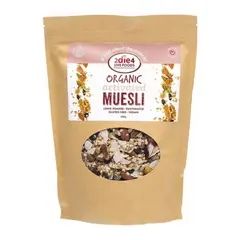
Ceres Organics Super Good Muesli Cacao Crunch
Ingredients: Oats*, Pumpkin Seeds*, Almonds*, Coconut Shredded*, Coconut Oil*, Sultanas*, Diced Dates* (Dates*, Rice Flour*), Brown Rice Puffs*, Cacao Powder* 4.9%, Coconut Sugar*, Brown Rice Malt Syrup*, Cinnamon*, Sea Salt (*Certified Organic)

Blue Frog Keto Almond Peanut Raspberry
Ingredients: Nuts 51% (Peanuts 27%, Almonds 16%, Organic Coconut), Seeds 36% (Sunflower, Pumpkin, Sesame, Organic Hemp, Flax, Organic Chia), Fibre Rich Tapioca Syrup, Freeze Dried NZ Raspberries (1%), Natural Vanilla Extract, Organic Monk Fruit, Sea Salt, Natural Antioxidant (Rosemary Extract).
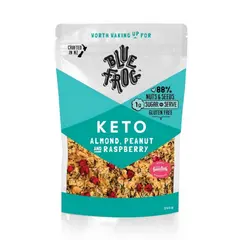
Farmer Jo Maple Granola with Roasted Almonds & Sea Salt
Ingredients: Wholegrain Oats, Almonds (7%) (Raw Almonds, Blanched Almonds), Maple Syrup (3%), Honey, Muscatel Raisins, Currants, Coconut, Pumpkin Kernels, Sunflower Kernels, Macadamia Oil, Cinnamon, Sea Salt.
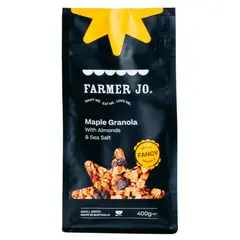
Blue Frog Cashew Almond Maple
Ingredients: Nuts 58% (Almonds 30%, Cashew 20%, Coconut), Seeds 29% (Sunflower, Pumpkin, Sesame), Honey, Organic Maple 1.5%, Rice Bran Oil, Fibre Rich Tapioca Syrup, Cinnamon, Vanilla Extract, Sea salt, Natural Antioxidant (Rosemary Extract).

2Die4 Holy Cacao! Cacao Granola Clusters
Ingredients: Sunflowers Seeds, Buckwheat, Cashews, Coconut Sugar, Pecans, Coconut Flakes, Pistachios, Currants, Cacao Powder, Desiccated Coconut, Cinnamon Powder, Vanilla Powder.
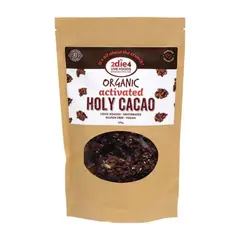
Ceres Organics Golden Crunch Muesli
Ingredients: Oats* 64.4%, Nuts & Seeds 20% (Cashews* 5.4%, Pumpkin Seeds* (Pepitas), Sunflower Seeds*, Coconut Chips* 3.7%, Sesame*, Linseed* (Flaxseed), Coconut Nectar*, Coconut Oil*, Coconut Sugar* (*Certified Organic)
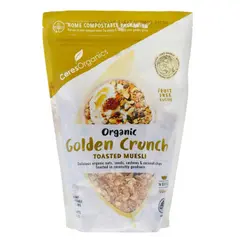
The Monday Food Co Paleo Granola Hazelnut, Fig & Cardamon
Ingredients: Almonds**, Hazelnuts* (15%), Sunflower Seeds*, Pepitas*, Shredded Coconut*, Honey*, Coconut Oil*, Figs* (5%), Linseeds*, Cardamom* (2%), Cinnamon*, Himalayan Salt*. **Spray Free *Organic
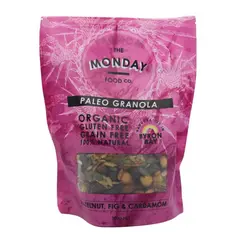
How to read the ingredient list on cereal boxes:
When choosing a healthy muesli or granola, the first thing to examine is the ingredients. Let’s use the following product as an example:
Blue Frog Keto Almond, Peanut & Raspberry
Ingredients: Nuts 51% (Peanuts 27%, Almonds 16%, Organic Coconut), Seeds 36% (Sunflower, Pumpkin, Sesame, Organic Hemp, Flax, Organic Chia), Fibre Rich Tapioca Syrup, Freeze Dried NZ Raspberries (1%), Natural Vanilla Extract, Organic Monk Fruit, Sea Salt, Natural Antioxidant (Rosemary Extract).

We can see that this product is 51% nuts and 36% seeds, which makes it 87% nuts and seeds. This is fantastic because it means it’s going to be a more filling option than one that is predominately whole grains. Among the other ingredients are a freeze dried fruit, which is healthier than ‘dried fruits’ and a small amount of natural sweetener. This product passes the test by being made up of real food ingredients.
What to look for on the nutritional panel:
After looking at the ingredients list (like we’ve done above), we can move on to the breakdown of macronutrients.

One of the first things to look at on the nutritional panel is the sugar content. To do this, it’s best to look at the content per 100g. This gives us a percentage amount, in the case of the Blue Frog example above, it has 2.3g of sugar, which is the equivalent to 2.3%. Ideally we want the sugar content to be under 10% for a breakfast cereal, so the above option is a great example of this.
Another helpful thing to look at is the protein content, the amount of protein a food contains can contribute towards how filling it is, as well as it going towards our daily protein requirement. As a general rule, we need at least 0.75g of protein for every 1kg of body weight we have. This means that someone who weighs 80kg would need at least 60g of protein per day. As we have 3 main meals, we want to get around a third of this through our breakfast.
It can be beneficial to calculate your personal protein requirements and then aim to hit a third of the total through your breakfast. Not all of your protein needs to come through the muesli or granola itself, it can be bulked up with the foods you serve it with. For example by adding yoghurt and/or milk.
Please note that this is the minimum protein requirement and it is likely that you need closer to 1g of protein per 1kg of body weight. Consult a nutritionist or natural health professional if you’d like additional guidance on how much protein you need for your personal requirements.
Dietary fibre is another value that we can consider when choosing healthy breakfast options. Australian guidelines suggest we need a minimum of 25g per day for females and 30g per day for males. We can see that a serve of this product provides 7.2g of fibre, which is a good amount and is getting us closer to our daily goal.
What else should you consider when choosing a healthy cereal?
Healthy mueslis and granolas contain real foods, which naturally contain nutrients. When a product contains fortified nutrients, this can be a red flag. This is because when a product has been fortified, it’s likely because the ingredients that are present within it have been processed and they have lost their nutrition content. This isn’t always the case, but is something to be mindful of. It’s definitely worth seeing the pattern in the way that majority of the processed cereals contain fortified nutrients, while most mueslis and granolas don’t.
What are sulphites and why should we avoid them in this product?
While sulphites are naturally present in some foods, they’re also used as a preservative in many dried fruits. Did you know that dried apricots are actually supposed to be brown and that the only reason they have that bright orange colour that they’re often associated with is because of the use of preservatives like sulphites. Sulphites may trigger allergies, including respiratory symptoms or hives. For this reason, it’s best to avoid them and stick to mueslis and granolas that don’t contain dried fruits or that use a healthier alternative like freeze dried fruits or preservative free dried fruits.
What does an unhealthy cereal look like?
Unhealthy cereals tend to have long ingredient lists, with many ingredients that don’t match the real food criteria. Let’s take a look at one that is marketed as good for us, but wouldn’t be a healthy option:
Uncle Tobys Cereal Plus Protein
Ingredients: Whole Grain Cereals (50%) [ Wheat (44%), Oats (6%)], Sugar, Wheat Gluten, Corn, Wheat Flour, Peach Fruit Pieces [Concentrated Peach Puree (1.4%), Concentrated Apple Puree, Concentrated Pear Puree, Invert Sugar, Sugar, Humectant (Glycerine), Wheat Fibre, Food Acid (Malic), Gelling Agent (Pectin), Flavour], Sultanas (5%), Oat Fibre, Malt Extract ( Barley ), Puffed Rice, Golden Syrup, Honey, Salt, Sunflower Oil, Tapioca Flour, Flavours ( Milk ), Cocoa Powder. Vitamins and Minerals Minerals (Calcium, Iron, Zinc), Vitamins [Niacin, E, B2, B6, B1, Folic Acid].

Right away looking at the length of the ingredients list we can sense it’s not going to be pretty… One notable thing is that added sugars appear more than 5 times, under multiple names including sugar, golden syrup, honey, malt syrup and invert sugar.
The ‘whole grains’ used in this product have been processed into flakes and bran sticks, taking them out of their natural form and being much more refined. We’d much prefer to see the wholegrain in their less processed form (for example whole rolled oats).
This cereal also has artificial flavours, which is an umbrella term for any number of chemicals that are used to obtain a particular flavour profile. It contains glycerine, which is derived from vegetable oils and is not only highly processed, but can also contribute towards inflammation within the body.
While not the highest sugar content for a cereal, this product still contains more than we want to see in a breakfast cereal, especially because it’s coming from added sugars. The percentage of sugar is 18.7%, which means almost one fifth of this product is added sugar.
We can also see that the protein is on the lower side, with only 5.6g per serve. This alone isn’t a problem because we can bulk up the protein in the way that we serve it, but combined with the other reasons this cereal isn’t a healthy option it’s not doing it any favours.
Our top 3 cereals to avoid and why:
While it would be easy to write a whole blog post on the many cereals to avoid, we’ve selected the top 3 that are among the highest sugar content options on the market:
Kellogg’s Frosties Breakfast Cereal
Ingredients: Corn (59%), sugar, salt, barley malt extract, vitamins (vitamin E, niacin, vitamin B6, riboflavin, folate), minerals (iron, zinc oxide).

This particular breakfast cereal is made predominately of highly refined corn and sugar. The corn has been so refined that it has been moulded into the final shape of this cereal. The more we process our food, the more nutrients we lose and the less beneficial it is towards our health.
While the ingredients list is relatively short, there are two forms of added sugar in this cereal. This brings the total sugar content to 41.3%, which is sure to send our blood sugar levels into a panic and lead to a crash later in the day.
The salt used in this cereal is also a processed salt, rather than a sea salt or Himalayan rock salt. This means that it would have less of the trace minerals that are normally present in a good quality salt.
Kellogg’s Fruit Loops
Ingredients: Cereals (60%)(maize flour, wheat flour, oat flour), sugar, vegetable oil, salt, natural colours (paprika extract, carmine, curcumin, vegetable carbon, copper chlorophyll), minerals (iron, zinc oxide), vitamins (niacin, vitamin B6, riboflavin, folate), natural flavours (orange, lemon, lime).

It’s probably no surprise to see this one on the list, the appearance alone is a bit of a giveaway that this cereal isn’t a healthy option.
Using highly processed grains, we loose a lot of the fibre and nutrients that would have naturally been present in the whole grain. Sugar is the second ingredient and makes up 38.8% of the product. This cereal also has vegetable oil, which is generally inflammatory for our body.
While it may seem like a good thing that it has added vitamins and minerals, this is an example of a brand fortifying their cereal because it is naturally void of important nutrients.
Kellogg’s Coco Pops
Ingredients: Whole white rice (64%), sugar, cocoa (3%), minerals (calcium carbonate, iron, zinc oxide), salt, natural flavour, barley malt extract, vitamins (niacin, riboflavin, vitamin B6, folate).
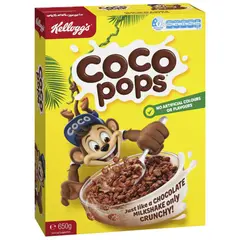
Just like a chocolate milkshake, only crunchy’ is the catch phrase of this cereal, which tells us a lot about what we can expect from a health perspective. While the main ingredient is rice, it uses white rice which has been more processed than other kinds and is lacking much of the dietary fibre. The product is also made up of 32.3% sugar, which is much higher than the suggested 10% or less of sugar that we like to see in a breakfast cereal.
An easy way to summarise this blog post is that ‘cereals’ are generally a no-go zone, while muesli and granolas are more likely to be a healthy option. The best thing we can do is to look for those that are made up of real foods and naturally low in sugar. If we can get a good dose of protein and dietary fibre in then that’s an extra bonus.
Muesli and granolas are also an easy option to make yourself at home. Just mix whole grains like rolled oats, with nuts and seeds of your choice. Coconut is a great addition too and if you’re turning it in a granola don’t forget some coconut oil and a natural sweetener like honey or maple syrup. You can find all of the supplies you need via the GoodnessMe shop.
We love serving muesli and granola with a generous dollop of greek yoghurt and some fresh seasonal fruit. This helps balance it out by bulking up the protein and healthy fat content and is likely to keep us fuller for longer.
Shop Breakfast Essentials

